
Assessing citrus crop load
Summary
Citrus crop load is largely determined by flowering intensity and flower type, as well as environmental factors affecting fruit set. In citrus, crop load and fruit number are inversely related to fruit size. This means the higher the number of fruit, the smaller the fruit size. Crop load is largely responsible for the year to year variation in fruit size.
Assessing crop load is essential when making appropriate management decisions to achieve the best fruit size. It provides an indication of whether a heavy, medium or light crop is expected. It is particularly useful when there is a heavy crop load as it allows you to undertake suitable crop reduction strategies such as chemical or hand thinning.
When to measure crop load
Measuring crop load involves counting the number of fruit in a given canopy volume, which gives you a fruit density count.
If you are considering using chemical thinning, the best time to measure the crop load is near the end of the natural fruit drop period. This usually occurs between November and December when fruitlets are about 10–15 mm in diameter. However, exact timing can vary depending on the region, variety and seasonal conditions. Monitoring and recording fruit drop will help to more accurately identify the correct time to measure crop load. Fruit drop can be monitored by catching the fallen fruit (using a piece of shade cloth) under a few selected indicator trees every 2–3 days. Once the fruit drop rate significantly declines, then crop load can be measured.
For hand thinning, the best time to measure crop load is at the beginning of the Stage II fruit growth (late December to early January) when fruit size is about 30–40 mm.
What you need
You will need a 0.125 m3 counting frame (0.5 m × 0.5 m × 0.5 m) with 0.5 m prongs at each corner (Figure 1). Using aluminium for the frame will reduce the weight. The rear of the frame can be made out of 20 mm diameter tubing and the prongs out of 16 mm diameter tubing. Only 1 mm thick tubing is required as this will reduce the weight. A small clipboard can also be attached for holding the recording sheet.
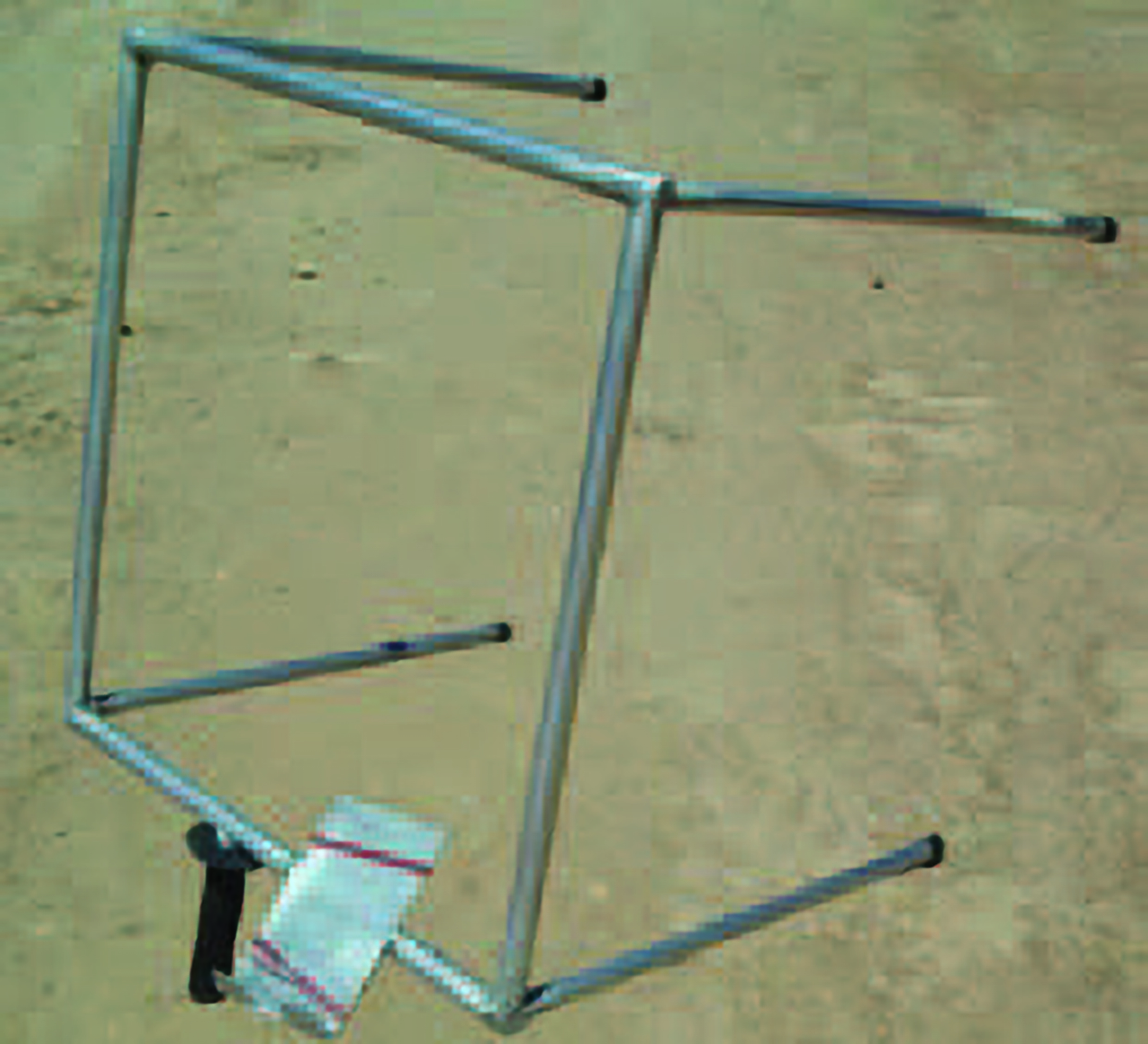
How to measure crop load
As a guide, measure the crop load of at least 20 trees (per 1-hectare block). These trees should be the same age and variety/rootstock combination. The more fruit density counts you do, the more representative the results will be for that block. For blocks larger than 1 ha, increase the number of sample trees.
The number of frame counts to do per tree depends on the planting system used and its effect on the crop distribution pattern within trees. Crop load often varies on different sides of the tree. As a guide for a standard planting of mature trees running north-south, measure at least 2 sides of the tree (east and west), which equates to 2 frame counts per tree. For hedge rows, trees either side of the row can be measured. Frame counts for each side of the tree can be recorded in separate columns so you can observe any differences.
Randomly place the frame in the tree, being careful not to show preference for areas of high or low crop loads. A good method to help randomly select the area to be measured is to select it from a considerable distance (e.g. 10 m, Figure 2) when fruit are hard to see and place the frame into the tree without directly looking at it (Figure 3).
The frame is placed in the tree canopy with the prongs pointing towards the trunk and the outer edge of the frame at the edge of the canopy (Figure 4), about 1.0–2.5 m from the ground. Do not alter the position of the counting frame even if there is very little or an over abundance of fruit or canopy within the frame.
Sometimes most fruit can be in the upper parts of the canopy, which could give misleading counts. This is usually the case in orchards with high density plantings (e.g. Imperial mandarin orchards) which cause shading in the lower parts of the tree canopy, resulting in very high crop loads in the tops of trees and none in the lower parts of the canopy. These differences in the distribution of fruit should be considered when taking crop density measurements.
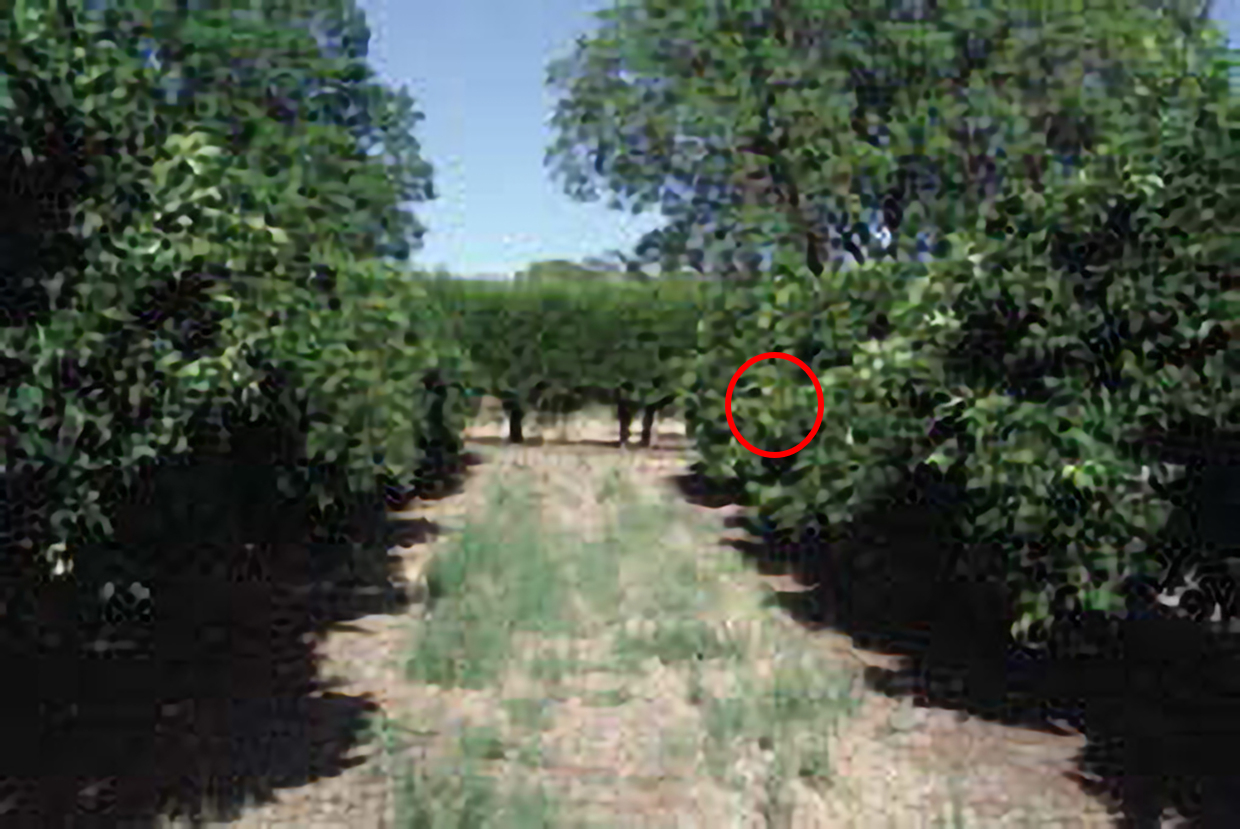
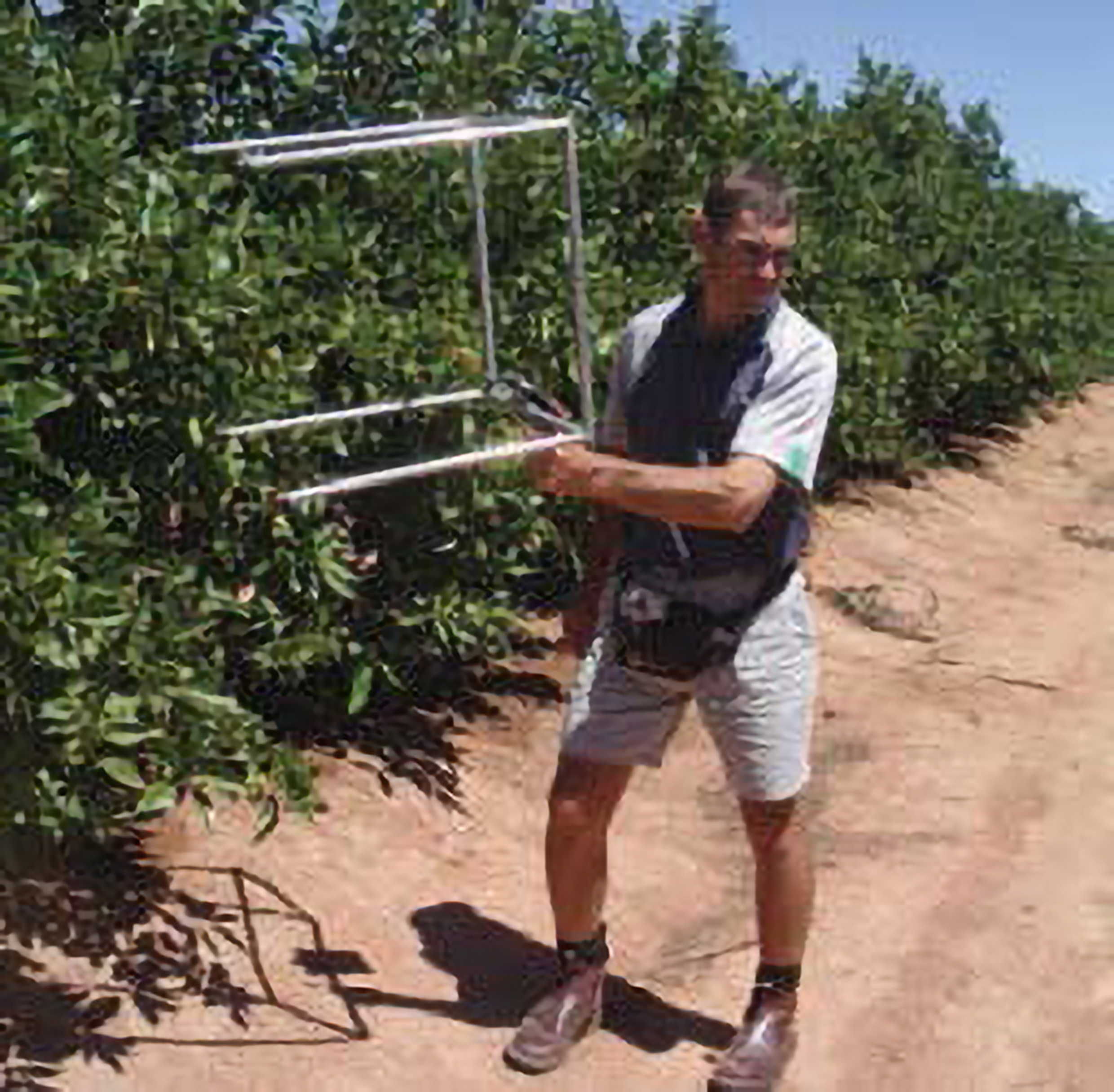
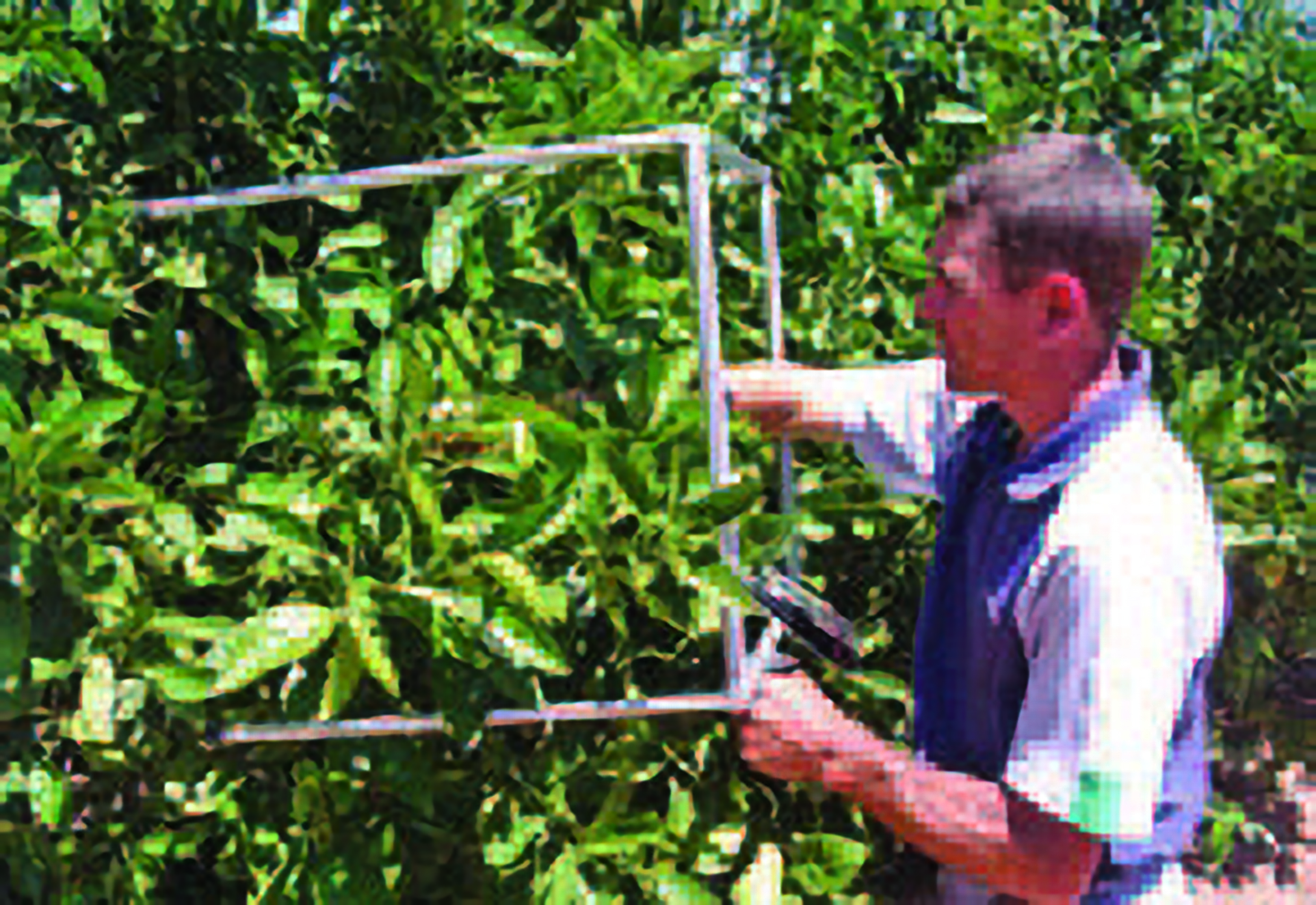
Counting fruit
Count the number of fruit within the counting frame. Green fruit are sometimes difficult to see in a dense canopy, so move your hands through the canopy to uncover any fruit hidden by the foliage. Do not count any fruit which are about to fall; these are paler and smaller. Before counting, brush the foliage with your hands to knock off any fruit about to fall. Record your results.
Repeat this sampling procedure at least 40 times throughout the block (1 ha); more samples will be required for larger blocks. The accuracy of results improves as the sampling number increases.
Working out average frame count
The individual frame counts are then added together and divided by the total number of frame counts to get the average frame count. For example: if you counted 500 navel orange fruit from 40 separate frame counts, then you would have an average frame count of 12.5 (500 ÷ 40 = 12.5). See Table 1 for an example record sheet.
Table 1. Example of a crop load record sheet.
Frame | Count | Frame | Count |
1 | 9 | 16 | 8 |
2 | 6 | 17 | 10 |
3 | 11 | 18 | 14 |
4 | 10 | 19 | 11 |
5 | 12 | 20 | 11 |
6 | 6 | 21 | 13 |
7 | 7 | 22 | 9 |
8 | 9 | 23 | 10 |
9 | 10 | 24 | 11 |
10 | 7 | 25 | 9 |
11 | 13 | 26 | 7 |
12 | 10 | 27 | 6 |
13 | 8 | 28 | 8 |
14 | 6 | 29 | 12 |
15 | 8 | 30 | 11 |
Total | 132 | Total | 150 |
Total: 132 + 150 = 282
Average frame count: 282 ÷ 30 = 9.4
Interpretation and crop management strategies
The accuracy of estimating yield improves as crop load measurements are conducted over several years, especially when cross referenced with actual harvest records. This will help to further refine the technique to your own conditions.
A critical component to frame counting is not being biased in selecting trees and parts of the tree canopy. A common problem is to subconsciously select areas that have more fruit and this problem increases as fruit become more visible (larger and coloured).
Frame counts when fruit are 10–15 mm in size
Frame counts conducted during November–December when fruit are 10–15 mm (Figure 5) are used to decide whether chemical thinning is an option. The frame counts should only be considered as a guide because a high degree of variation is common at this early stage as fruit are still falling and a further drop can occur, depending on climatic conditions. About 20–40% of the crop might drop after fruit reaches this stage and fruit generally stop dropping by early to mid January.
As a general guide, if the average count is more than about 8–10 fruit per frame for Washington navel oranges, then thinning should be beneficial.
However, thinning thresholds will vary for different varieties, growing districts, tree age and condition.
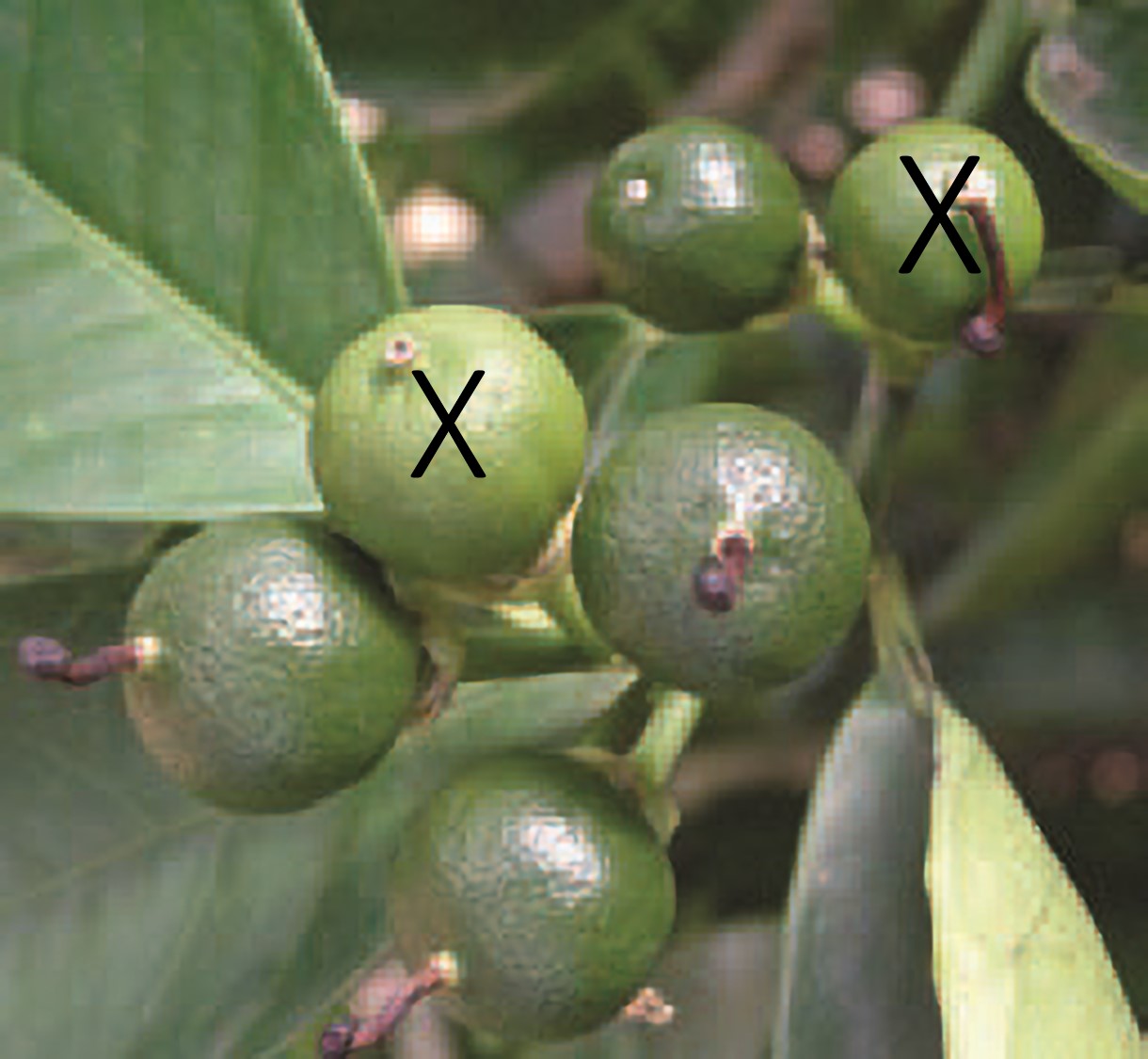
Frame counts when fruit are 30–40 mm in size
Frame counts conducted in mid December to mid January (30–40 mm fruit size) are used to determine the need for hand thinning and can also provide a preliminary yield estimate.
The actual number of good-sized fruit that trees can carry is dependent on several factors such as tree age, amount of fruit-bearing wood, tree health, variety and rootstock. As a guide, thin if average frame counts are more than 6–10 for Washington navels, 8–10 for Imperial mandarins in southern Australia and 10–15 in Queensland. If average frame counts are greater than this then hand thinning should be beneficial. Frame counts conducted closer to harvest (April onwards) can provide a better indication of yield for harvest logistics. Estimates made in this period using the yield estimator spreadsheet provide a reasonable indication of yield.
Crop management
It is beneficial to undertake all three measurements (early, mid and late) annually to monitor your crop better. If major differences in frame counts are noticed between measurement periods, this could alert you to possible problems in counting technique or indicate the amount of natural fruit drop during the season. Conducting all three measurements will help you to understand your crop so you can make better management decisions.
References
Bevington K and Khurshid T (2002) Optimisation of citrus production and fruit size: an interactive management model, Horticulture Australia Limited, final report for project CT98023.
Bevington K, Hardy S, Meville P, Thiel K Fullelove G and Morrish P (2003) Fruit size management guide, part 1, an Australian Citrus Growers publication.
Bevington K, Hardy S, Falivene S, Khurshid T, Fullelove G and Morrish P (2003) Fruit size management guide, part 2, an Australian Citrus Growers Publication.

